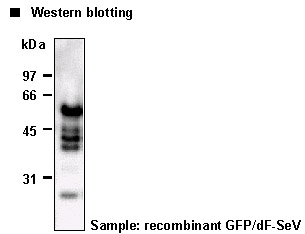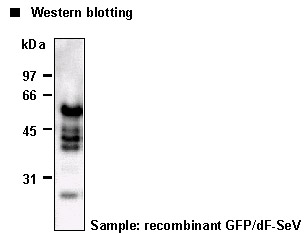Anti-Sendai Virus pAb
Product Code:
MBL-PD029
MBL-PD029
Host Type:
Rabbit
Rabbit
Antibody Clonality:
Polyclonal
Polyclonal
Regulatory Status:
RUO
RUO
Target Species:
Sendai Virus
Sendai Virus
Applications:
- Immunocytochemistry (ICC)
- Western Blot (WB)
Shipping:
4°C
4°C
Storage:
4°C
4°C
No additional charges, what you see is what you pay! *
| Code | Size | Price |
|---|
| MBL-PD029 | 50 ul | £361.00 |
Quantity:
Prices exclude any Taxes / VAT
Stay in control of your spending. These prices have no additional charges, not even shipping!
* Rare exceptions are clearly labelled (only 0.14% of items!).
* Rare exceptions are clearly labelled (only 0.14% of items!).
Multibuy discounts available! Contact us to find what you can save.
This product comes from: United States.
Typical lead time: 10-14 working days.
Contact us for more accurate information.
Typical lead time: 10-14 working days.
Contact us for more accurate information.
- Further Information
- Documents
- References
- Show All
Further Information
Applications:
WB - 1:2000 (chemiluminescence detection system) ICC - 1:500 (for methanol fixed cells)
Background:
Sendai virus (SeV), also known as murine parainfluenza virus type 1, is a negative sense, single-stranded RNA virus of the paramyxovirus subfamily Paramyxovirinae, genus Respirovirus, members of which primarily infect mammals. It was originally recovered in Sendai, Japan, so it is also called hemagglutinating virus of Japan (HVJ). SeV is responsible for a highly transmissible respiratory tract infection in mice, hamsters, guinea pigs, rats, and occasionally pigs, with infection passing through both air and direct contact routes. The virus can be detected in mouse colonies worldwide, generally in suckling to young adult mice. It is believed that the natural host of Sendai virus is the mouse and that the virus is usually nonpathogenic for humans. The SeV genome is organized starting with the short 3? leader region, followed by six genes encoding the nucleocapsid protein (NP), phosphoprotein (P), matrix protein (M), fusion protein (F), hemagglutinin-neuraminidase protein (HN), and large protein (L), and ending with a short 5? trailer region. The SeV now has been developed as gene transfer vectors for expressing foreign genes to a wide range of mammalian cells and tissues with high efficiency.
Formulation:
50 ul volume of whole serum containing 0.09% NaN3.
Immunogen Translated:
Sendai virus wild-type
Reactivity:
This antibody reacts with Sendai virus on Western blotting and Immunocytochemistry.
Shelf Life:
1 year
Source:
This antibody was whole serum. The rabbit was immunized with wild type Sendai virus.
Target:
Sendai Virus
Documents
References
Hach, J. C., et al., J. Virol. 87, 9923-9927 (2013) [FCM]
Macarthur, C. C., et al., Stem Cells Int. 564612 (2012) [IC]
Griesenbach, U., et al., Curr. Opin. Mol. Ther. 7, 346-52 (2005)
Iwadate, Y., et al., Clin. Cancer Res. 11, 3821-3827 (2005)
Kato, M., et al., Vaccine 23, 3166-3173 (2005)
Sasaki, K., et al., Gene Ther. 12, 203-210 (2005)
Inoue, M., et al., J. Gene Med. 6, 1069-1681 (2004)
Ferrari, S, et al., Gene Ther. 11, 1659-1664 (2004)
Matano, T., et al., J. Exp. Med. 199, 1709-1718 (2004)
Kinoh, H., et al., Gene Ther. 11, 1137-1145 (2004)
Shirakura, M., et al., Gene Ther. 11, 784-790 (2004)
Okano, S., et al., Gene Ther. 10, 1381-1391 (2003)
Inoue, M., et al., J Virol.77, 6419-6429 (2003)
Jin, C. H., et al., Gene Ther. 10, 272-277 (2003)
Tokusumi, T., et al., Virus Res. 86, 33-38 (2002)
Masaki, I., et al., Circ Res. 90, 966-973 (2002)
Yamashita, A., et al., J Immunol. 168, 450-457 (2002)
Shiotani, A., Gene Ther. 8, 1043-1050 (2001)
Masaki, I., et al., FASEB J. 15, 1294-1296 (2001)
Yonemitsu, Y., et al., Nat Biotechnol. 18, 970-973 (2000)
Li, H. O., et al., J. Virol. 74, 6564-6569 (2000)
Kato, A., et al., Genes Cells 1, 569-579 (1996)
Biotherapy 19, 85-92 (2005)




